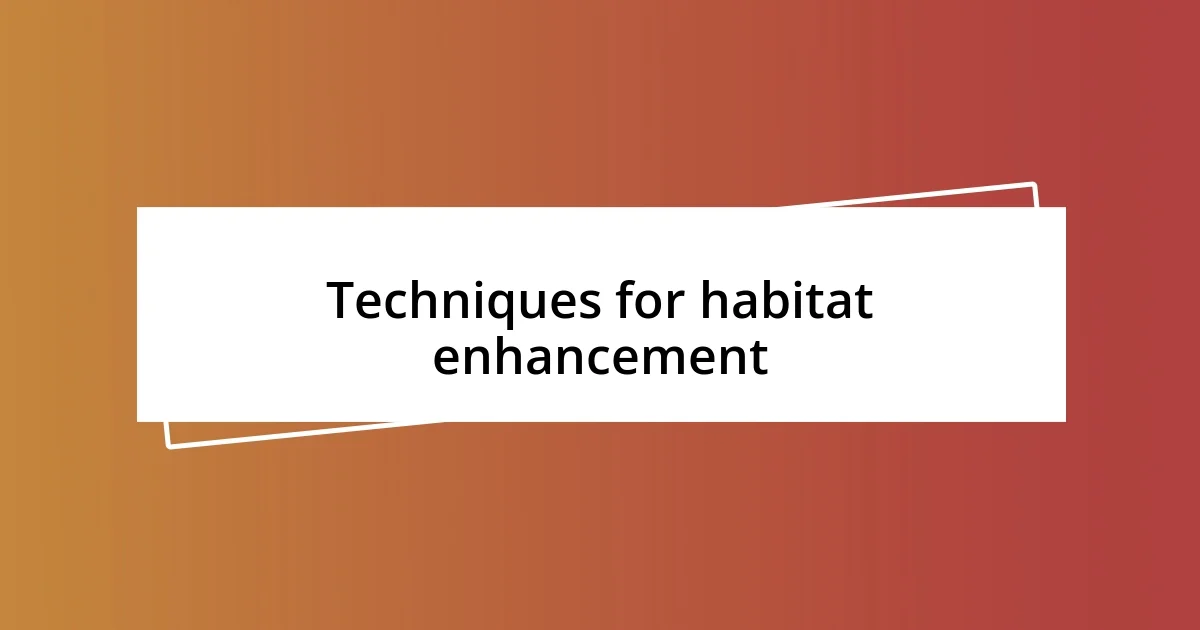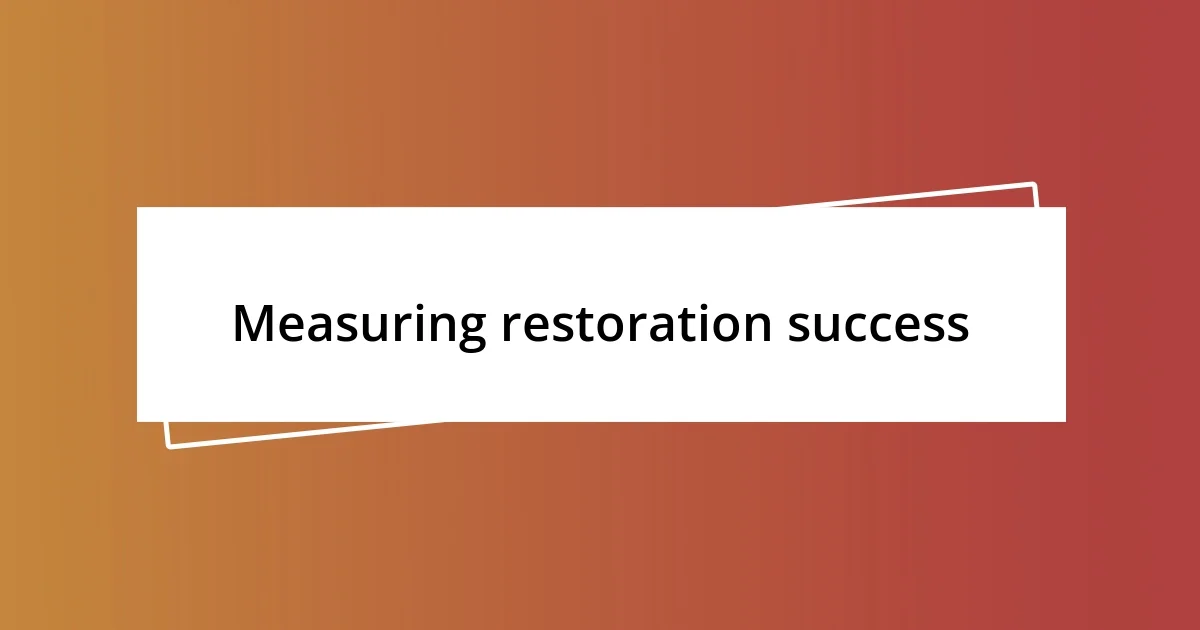Key takeaways:
- Indigenous plant restoration is about reviving ecosystems and the cultural significance of native flora, fostering connections between nature and communities.
- Local ecosystems provide vital services, support biodiversity, and hold both ecological and cultural importance, emphasizing our responsibility to protect them.
- Successful restoration requires careful selection of native species, effective propagation techniques, and engaging local communities to enhance stewardship and knowledge sharing.

Understanding indigenous plant restoration
Indigenous plant restoration is more than simply reintroducing native species into a landscape; it’s about reviving the stories and ecosystems that thrived there long before. I remember my first encounter with a restored site—it felt like stepping into a living museum. The vibrant colors and harmonious sounds of the local wildlife reminded me of the delicate balance we often take for granted. Isn’t it fascinating how much life teems within these native plants?
When I initially set out on my journey, I was overwhelmed by the diversity of indigenous flora, each plant holding a specific role within its ecosystem. There’s an intertwined relationship between plants, animals, and the land that truly amazed me. Just thinking about how a single flower can support countless pollinators makes me realize, what are we missing if we allow these connections to fade away?
As I engaged more deeply with community restoration projects, I started to grasp the cultural significance of these plants. For many Indigenous peoples, these species are not just flora but are woven into their identities and traditions. I’ve heard stories of elders teaching the younger generations to honor and recognize the importance of these plants, which makes me wonder: how can we help others appreciate their value in a way that transcends generations?

Importance of local ecosystems
Local ecosystems are vital to our environmental health, acting as natural systems that sustain both wildlife and human communities. I remember walking through a restored wetland and witnessing firsthand how certain plants played a role in filtering water and providing habitats. Each plant seemed to tell a story of resilience and interdependence, reminding me how these ecosystems work in perfect harmony—much like a finely tuned orchestra.
Here are some key aspects that highlight the importance of local ecosystems:
- Biodiversity: They provide a home for a diverse range of species, enhancing ecological balance.
- Ecosystem Services: Local ecosystems support essential services like clean air and water, soil fertility, and climate regulation.
- Cultural Significance: They often hold cultural and spiritual value for local communities and Indigenous peoples.
- Educational Opportunities: These ecosystems serve as living laboratories for learning about nature and ecological processes.
- Climate Resilience: They contribute to overall resilience against climate change by absorbing carbon and mitigating effects like flooding.
Every time I visit a local park or nature reserve, I’m reminded of the intricate web of life that depends on these ecosystems. It’s this connection that fuels my passion for restoration efforts and highlights our collective responsibility to nurture and protect these natural treasures.

Selecting native plant species
Selecting the right native plant species is crucial for successful restoration. I remember the excitement of choosing plants for my first project—each selection felt like a chance to invite life back into the soil. I learned that local species aren’t just pretty faces; they have adapted over time to flourish in specific conditions, forming essential relationships with local fauna. It’s almost magical how these plants can be the key to restoring balance in the ecosystem.
While researching, I stumbled upon the importance of understanding a plant’s ecological function. Some plants are amazing at stabilizing soil, while others might be indispensable for local pollinators. I distinctly recall a moment in a workshop where an expert explained how native grasses can prevent erosion; it truly opened my eyes. As I selected species for my projects, I found that it wasn’t just about aesthetics but about a living framework supporting a thriving community.
The process of selecting native plant species also requires a keen awareness of their cultural relevance. Each species has stories and meanings tied to the Indigenous communities in the area. During my journey, I came across accounts of how certain plants were used for food or medicine, and it struck me; connecting people to these plants enhances our restoration goals. It’s about rebuilding a relationship between nature and the community, which makes every choice in selection carry profound weight.
| Plant Type | Ecological Role |
|---|---|
| Native Grasses | Soil stabilization, erosion control |
| Wildflowers | Support for pollinators, enhance biodiversity |
| Shrubs | Habitat for wildlife, food sources for birds |

Best practices for plant propagation
When it comes to propagating native plants, the timing of seed collection and planting is pivotal. I vividly recall a chilly morning in early spring when I ventured out to collect seeds from a local wildflower. The excitement of gathering those tiny treasures felt like holding the future in my hands. I learned that seeds should be collected when they are fully ripe—this ensures better germination rates. Not only does this require a keen eye, but also an understanding of each species’ growth cycle. Have you ever waited for just the right moment to capture something beautiful? That’s the essence of successful propagation.
Water is another critical factor when propagating plants. Initially, I struggled with finding the right balance between too much and too little. I remember over-watering my first batch of seedlings, thinking that more water would lead to faster growth. Instead, I nearly lost them all. Through experience, I discovered that consistent moisture is essential, especially during germination, but excess water can suffocate roots and invite disease. Now, I often remind myself that in nature, patience is key. Have you ever felt the anticipation that comes from nurturing something small and watching it flourish? It’s a rewarding experience.
Lastly, creating a suitable environment for seedlings is incredibly important. I’ll never forget the time I set up a makeshift greenhouse using a simple plastic cover over a wooden frame. The thrill of watching my little plants thrive in that controlled climate was indescribable. Proper light, temperature, and protection from pests can make or break the propagation process. I’ve learned that a little extra effort in crafting the perfect space can yield remarkable growth. What measures have you tried to ensure a nurturing environment for your plants? It’s those small tweaks that can lead to monumental success in your restoration efforts.

Techniques for habitat enhancement
To enhance habitats for native plants, I found that incorporating layers of vegetation can significantly improve ecological balance. One memorable experience involved setting up a diverse understory of shrubs and wildflowers beneath taller trees. As I watched the interactions unfold—birds flitting through the branches while bees hovered over the blossoms—I couldn’t help but feel a sense of fulfillment. It highlighted the importance of creating microhabitats that support various species.
Another technique that resonates with me is soil improvement through the introduction of organic matter. I vividly remember the moment I decided to enrich my planting area with compost made from local materials. The transformation was almost instant. Incorporating this nutrient-rich layer not only boosted plant health but also attracted an array of beneficial insects. Have you ever noticed how vibrant a space can feel once you nourish the soil? It’s a reminder that the foundation truly matters.
Additionally, fostering a community approach can lead to greater habitat enhancement. During one of my projects, I organized a volunteer day to plant local species in a nearby park. The collective energy felt electric as we dug, planted, and shared stories. Engaging the community strengthens bonds and ensures that ongoing care is taken for the plants. How often do we overlook the impact of teamwork in restoration efforts? Together, we can create thriving habitats that resonate with both nature and the people who cherish them.

Engaging with local communities
Engaging with local communities has been one of the most rewarding aspects of my plant restoration journey. I remember a community workshop where I shared my experiences with indigenous plants. It felt magical to see the spark of curiosity in people’s eyes as they learned about the ecological roles these plants play. Nothing beats the feeling of connecting with others over a shared passion for nature and our environment. Have you ever experienced that thrill when you help someone discover something new? It’s those moments that keep me motivated.
One evening, I hosted a gathering to discuss the significance of native flora, and to my surprise, several attendees shared stories of their own connections to these plants. A local elder recounted how their family used particular herbs for medicine—a tradition that had faded over the years. I realized that these conversations go beyond education; they also foster cultural preservation. How often do we overlook the depth of knowledge embedded in our communities? It’s a treasure trove waiting to be explored.
Furthermore, I’ve learned that collaborative efforts can truly amplify our conservation impact. I vividly recall partnering with a local school to create a garden filled with native species. The look of pride on the children’s faces as they planted their first seedlings was priceless. It was more than just planting; it was planting seeds of knowledge and stewardship for future generations. Have you seen the difference that hands-on involvement can make? Engaging young minds connects them to the land and instills a sense of responsibility that can last a lifetime.

Measuring restoration success
Measuring restoration success can feel like a thrilling experiment, akin to watching a little garden evolve over time. I remember one project where we monitored plant growth over several seasons, taking photos and notes to capture changes. The gradual emergence of new life not only indicated success but also sparked joy every time I returned to the site. Isn’t it amazing how nature rewards our efforts?
One practical way I gauge success is by assessing biodiversity. During one restoration effort, I kept a close tab on the different species that began to flourish as I introduced indigenous plants. My heart swelled when I noted the return of butterflies and bees, indicating a healthy ecosystem. Have you noticed how the presence of certain species can reflect the overall health of a habitat? It’s like nature’s way of giving us a thumbs up.
Another essential component of evaluating success is community involvement. After implementing restoration techniques in a local park, I organized regular check-ins with volunteers to discuss progress. Their excitement and feedback provided invaluable insights—sometimes, they pointed out new plant growth or bird activity before I even noticed! How often do we realize that success isn’t just measured by numbers but by shared experiences and the joy of seeing others engage with nature? It reminds me that restoration is a collective journey, not just a personal one.














